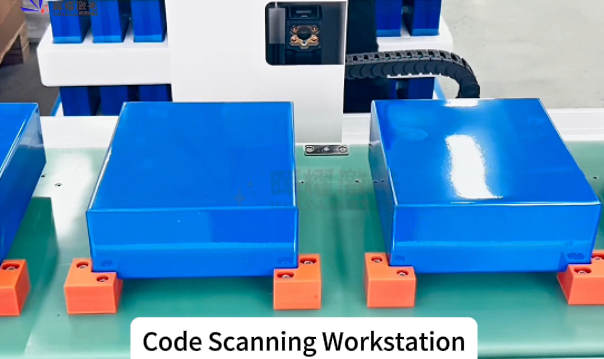Turnkey Solution for New Energy Intelligent Equipment
Welcome to today's module PACK line science trip! First of all, we are going to discuss several pr e-preparation stations in the module PACK line, which are not only related to the production efficiency of the battery module, but also the key to ensure the quality of the product. Next, we will introduce the automatic feeding, automatic code scanning, OCV inspection and NG rejection stations one by one according to the flow order of the production line.
Cell loading station
1. Function Description
The loading station is mainly manually responsible for manually transporting the cells from the storage area to the production line to ensure that the cells can smoothly enter the subsequent production process.
2.Operation flow
Preparation stage: The operator firstly confirms the type, quantity and location of the required battery cells, and prepares the necessary handling tools. ·
Loading stage: the operator will carry the cores one by one from the storage area to the designated position on the production line according to the requirements of the production line.
Inspection Stage: During the loading process, the operator needs to carry out a preliminary inspection of the cells to ensure the integrity and quality of the cells. ·
Recording stage: After completing the loading, the operator needs to record the model and quantity of the battery cell, so as to facilitate the subsequent production management and quality traceability.
3.Precautions
Operators need to stay focused during the loading process to avoid misoperation or safety accidents. For large or heavy cells, operators need to use appropriate handling tools to ensure the safety and efficiency of the handling process. Before loading, operators need to perform safety checks on the equipment in the production line to ensure that the equipment is in normal working condition.

Automatic code scanning station
1.Functional description
The automatic code scanning station is responsible for reading the two-dimensional code information on the battery cell and entering the data into the system to provide data support for the subsequent processes.
2.Technical features
High-precision code-scanning equipment: adopts high-precision code-scanning technology to ensure fast and accurate reading of electric cell information. ·
Data storage: the read data is directly deposited into the system database, which is convenient for subsequent quality tracing and batch management.
Dull-proof function: with cell polarity dull-proof detection and re-coding dull-proof function to ensure the accuracy of the information.
2. Operation process
When the battery cell arrives at the code scanning station, the code scanning equipment automatically reads the information of the battery cell and sends the data to the system. If there is any abnormality, the equipment will issue an alarm and place the battery cell on the NG table.

OCV testing station
1. Functional description
OCV testing station is responsible for measuring the open circuit voltage (OCV) of the battery cell to evaluate the performance of the battery cell.
2.Technical features
High-precision measuring equipment: adopts high-precision measuring technology to ensure the accuracy of OCV data. ·
Rapid testing: complete the OCV measurement of the battery cell in a short period of time to improve the production efficiency. ·
Data analysis: Based on the OCV data, the health condition and remaining capacity of the battery cell can be judged. 3. Operation flow: After the battery cell arrives at the OCV inspection station, the measurement equipment automatically measures the OCV value of the battery cell and sends the data to the system. The system will judge whether the cell is qualified according to the set standard and make corresponding processing.

NG rejecting station
1. Function
NG rejecting station is responsible for identifying and rejecting the battery cells with poor performance or not meeting the production requirements.
2.Technical features
Detection device: equipped with high-precision detection device, it can quickly identify unqualified battery cells. ·
Rejecting mechanism: with reliable rejecting mechanism, it can reject the unqualified battery cells from the production line. ·
Alarm device: once the substandard battery cells are found, the alarm device will immediately issue an alarm and remind the operator to deal with it in time.
3.Operation flow
When the OCV inspection station finds unqualified battery cells, the system will send a command to the NG rejecting station. The rejecting mechanism will reject the unqualified core from the production line according to the instruction, and remind the operator to handle it through the alarm device. At the same time, the system will automatically record and store relevant data for subsequent quality traceability and analysis.
Overall, the cell loading station, automatic code scanning, OCV inspection and NG rejection stations are the key stations in the module PACK line. They ensure accurate feeding, information recording, performance testing and quality control of the battery cells through automated equipment and precision technology. The stable operation of these stations is of great significance to improve the productivity and product quality of the module PACK line.

Email: sales@huiyaolaser.com
Head Quarter Address: Huiyao Laser Technology, Building 2, Langxu Industrial Park, Guanlin Road, Science Park Street, Luolong District, Luoyang City, Henan Province, China
Research&Development Center: Room 901-9,Building B1, Phase 1, Southern Area, Baoneng Science and Technology Park, Qinghu Industrial Zone, Gangtou Community, Batian Street, Longgang District, Shenzhen City.